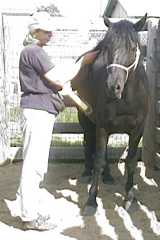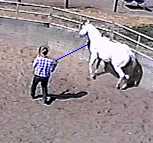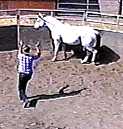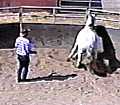|
|
|
BASIC GENTLING APPROACHES:
| |
|
SETTING UP THE DRAW
|
|
Problem: I can get close to the horse but I still can't get my
hands on him.
Since the horse has greater confidence if he approaches the scary
object than if the object is approaching him, oftentimes first
contact can be gained more effectively by letting the horse make
the move. Once you find the neutral zone and can approach fairly
close to the horse you can try to draw the horse to you.
You can get the horse to come toward you in a couple of ways.
With a very forward horse you can just let him run around for a
while in the round pen until he looks in at you. At that
point you can apply slight pressure just forward of the drive
line, just enough to get his attention, then back up and
move slightly behind the drive line. Many horses will
recognize this as a non threatening gesture and bend around towards
you. This maneuver is known by many names such as "The Draw," "Join
Up," "Hooking Up," etc.
With a quiet or stoic horse you may find it more effective to set up
the draw through advance and retreat. In this case you put enough
pressure on the horse during the advance that he just starts to move
off, then back up to draw that movement towards you. It may take a few attempts
to get the feel of this but if you start your draw just as the horse
unlocks his legs and starts to move, he should naturally want to fill
in behind you.
If this process doesn't work at first, just tune up your approach and try
again. The idea is to keep the work as quiet and stress free as possible.
Let the horse come to you. It make take several attempts before his
confidence builds up sufficiently to stifle his instinctive wariness of
you. When the horse does make contact, settle for a short, quiet and gentle
touch, then quietly back away. He has to understand that coming to you, not leaving, was
OK. If you push things until he leaves, he's more likely to feel that
he "escaped" from you.
|
The Horse is moving and I back up
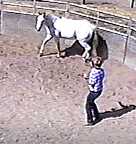
The horse starts to follow

The horse continues to follow
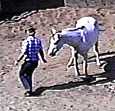
And eventually catches up
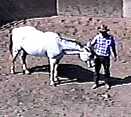
|
|
|
BASIC GENTLING APPROACHES:
| |
|
OPERANT CONDITIONING (Clicker Training)
|
|
One of the most successful and safest approaches to gentling wild horses is
"Clicker Training." This approach uses a marker "clicker" and reward method for
shaping behavior. Virtually every horse quickly picks up on this approach
and they can be taught to be haltered, stand still for grooming, lift feet for
cleaning and trimming as well as a host of other behaviors that would otherwise
be very foreign and anxiety producing to the horse.
Clicker training involves the use of treats in a very controlled environment so
that the horse doesn't equate the handler as a walking buffet and be constantly
begging for handouts. It does, however, require the horse to recognize treats.
We find carrots to make ideal treats. They can be grated onto the horse's hay
so that he will acquire a taste for them. They can be cut into slender spears for
horses that don't take treats by hand very well. Then they can be cut into thin
oval slices so that a few carrots will go a long way when you're heavy into the
clicker training.
Besides teaching new behaviors, clicker training can be used to interrupt stress
cycles and to keep the horse focused on learning, all through using motivation
rather than correction.
|
Targeting a scary object
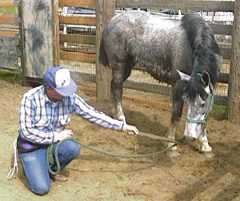
Wild horse's first trim.
This 6 Y.O. former stallion was
taught to place his foot on the
stand using clicker training.
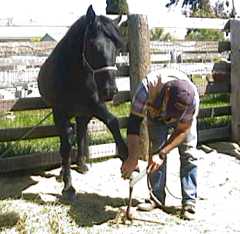
|
Important Note: If you take on the project of developing an untrained horse, everybody will want to give you advice. Don't act on any advice, including the ideas offered in this site, unless it makes sense to you and fits your individual situation. Your abilities and the sensitivities of your horse(s) may differ from the examples given. Be alert and rational with your actions so neither you nor your horse will get hurt. This information is offered as illustrations of what we do and the reader must apply common sense since he or she is solely responsible for his or her actions.
Happy trails!
Press Back to return to the page which brought you here
KBR Horse Training Information, © 2000 Lamm's Kickin' Back
Ranch and Willis & Sharon Lamm. All rights reserved. Duplication of any of this material for
commercial use is prohibited without express written permission. This prohibition is
not intended to extend to personal non-commercial use, including sharing with others for
safety and learning purposes, provided this copyright notice is attached.
Email us to submit comments or request reproduction
permission.
|
